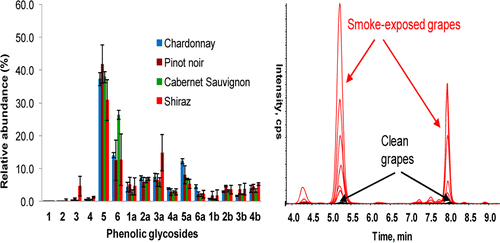New way to identify 'smoked' grapes and wines

With climate change sparking concern about an increased risk of wildfires, scientists are reporting development of a way to detect grapes exposed to smoke from those fires, which otherwise could be vented into bad-tasting wine. Their report on the method for detecting smoke taint in both grapes and wine appears in ACS' Journal of Agricultural and Food Chemistry.
Yoji Hayasaka and colleagues point out that Australia and other areas of the world are experiencing an increase in bush and wildfires, which may continue and intensify with global climate change. Smoke from those fires can travel long distances and poses a special threat for wine grapes. Grapes exposed to smoke yield wines with unpalatable aromas and tastes, sometimes described as resembling "smoked meat," "disinfectant" or a "dirty ashtray."
In an effort to manage or avoid production of smoke-tainted wines, they developed a test for the substances formed in grapes after exposure to smoke. They describe its development and laboratory tests demonstrating that the method can determine whether grapes have been smoke-tainted before they were crushed and pressed into wine. The test also can identify smoked wines.
More information: "Assessing the Impact of Smoke Exposure in Grapes: Development and Validation of a HPLC-MS/MS Method for the Quantitative Analysis of Smoke-Derived Phenolic Glycosides in Grapes and Wine" J. Agric. Food Chem., 2013, 61 (1), pp 25–33. DOI: 10.1021/jf305025j
Abstract
Bushfires occur frequently in the vicinity of grape growing regions, resulting in smoke drifting over the vineyards. Wine made from smoked grapes is often downgraded or unfit for sale due to negative sensory characters. To manage or avoid the risk of producing smoke-affected wine, a diagnostic assay was developed for assessing the extent of smoke exposure in grapes and the resulting wines. The method relies on the quantitation of the glycosidic grape metabolites that are formed from major volatile phenols present in smoke. Using HPLC-MS/MS with APCI, a quantitation method for phenolic glycosides as smoke marker compounds was developed and validated. The method was confirmed to be of sufficient sensitivity and reliability to use as a diagnostic assay. On the basis of phenolic glycoside concentrations, grapes or wine can be assessed as smoke exposed or not, and the relative intensity of smoke exposure can be determined.
Journal information: Journal of Agricultural and Food Chemistry
Provided by American Chemical Society

















